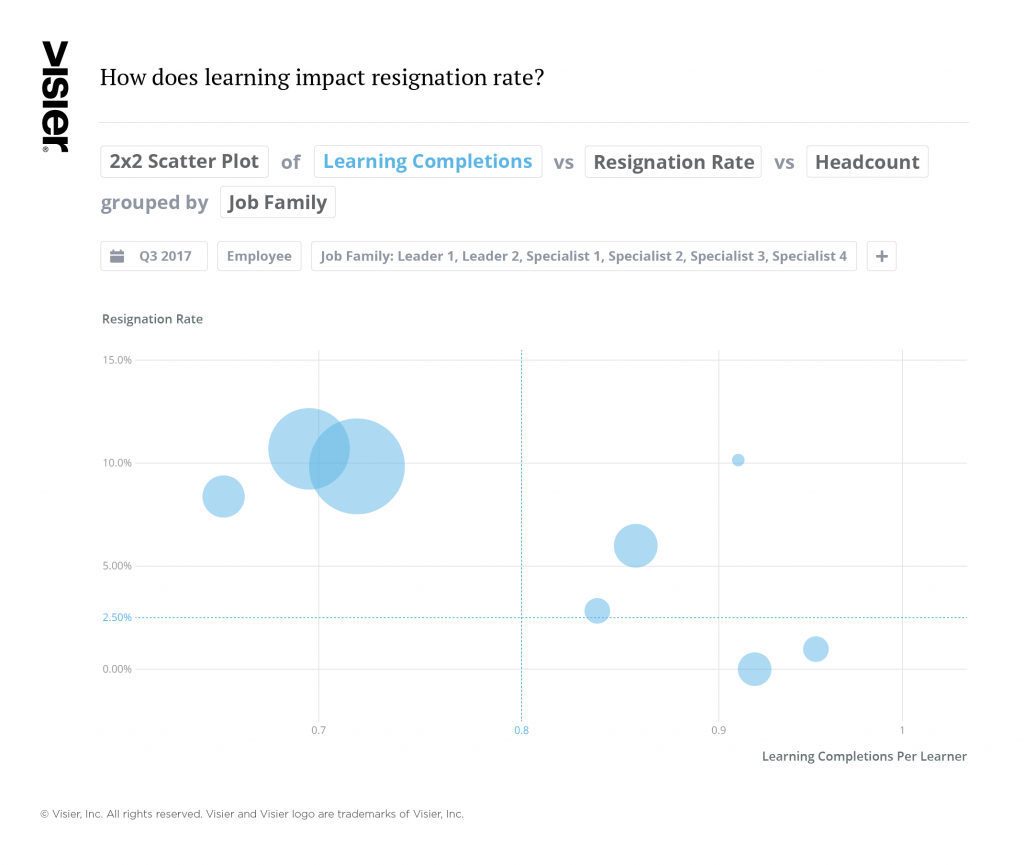3 Ways People Analytics Prepares You for the Future
Predictive people analytics make a positive impact on 3 key areas: the recruiting process, personalizing work, and identifying skills gaps.

The market has shown that when it comes to employment, we’ll continue to see the trend of record-low unemployment rates, an aging workforce that continues to remain involved in the labor market, and voluntary resignations and people movement at an all-time high. With all these factors in place, have you taken the appropriate steps in preparing your business for the workforce of the future?
If your answer to that question is no, take solace in the fact that you aren’t alone. A recent report from PricewaterhouseCoopers (PwC) entitled “Preparing for the workforce of tomorrow, today” found that the majority of the companies surveyed are struggling to make concrete decisions about their workforce. In fact, in identifying some of the top threats organizations are facing for the future, 4 of the top 10 “at risk” capabilities related to the implementation of workforce analytics.
Data analytics—particularly, predictive analytics—can give businesses a critical edge in gauging future talent needs, understanding how to create a compelling people experience, and eliminating potential biases in selection, assignment, and appraisal. Yet, despite the importance organizations attach to data analytics in planning and supporting the workforce of the future, the wealth of data they hold, and the growing sophistication and usability of the tools on offer, only a quarter of all businesses surveyed were using data analytics in workforce decision-making.
This is a critical misstep and one that can dramatically impact the future of an organization. Let’s look at three key areas of impact.
De-Biasing the Recruiting Process
True bias-free recruitment has been a challenge for every organization, large or small. The problem can stem from the fact that bias is often unconscious, which makes it hard to identify and even harder to address. If implemented properly and monitored, data-driven recruiting can be extremely effective at de-biasing the process, but the same study from PwC found that 72% of companies had no capabilities in place to use analytics to de-bias the hiring process.
Possible solutions range from the greater use of data analytics to promote diversity to the use of “blind” screening to eliminate potential sources of bias, such as gender; indicators of social backgrounds, such as names of educational institutions; or ethnicity.
However, companies should take care in how they implement their artificial intelligence (AI) or data solutions, especially when it comes to biases. Used the wrong way, people analytics can be just as unfair, particularly if they reflect human biases. Take, for example, when Amazon had to scrap its AI recruiting program that was showing its own bias against women.
Personalized Work
People’s personal lives and their work lives are not mutually exclusive, and what people do outside of work will inevitably impact their day to day. This is particularly true when it comes to how people are being impacted through the development of personalized experiences through sectors like retail, social media, and online entertainment (think personalized Netflix recommendations).
Why is this important to organizations? Because it’s shifting the mentality of your workforce. Outside of work, people are increasingly demanding, and being given, experiences that are tailored to their own needs and desires. Customization is creating a culture where people are accustomed to feeling like brands are listening and engaging with “just them,” so why should employers be exempt?
Employees are increasingly wanting the same speed, intuition, and customization within their workplace. Groupwide assessments and templated annual engagement surveys are not enough to make employees feel like they are valued in an organization. This is where data analytics can play a role.
Analytics can help leaders personalize the people experience, such as through mapping real-time career journeys to individuals. This can demonstrate value through clear skills development, promotional tracks, core pain points, and more to create a unique experience for each employee.
Identifying Skills Gaps
In an era of digital disruption, new types of jobs (like social media director or programmatic advertising manager) are continually cropping up. This means that gauging recruitment success based on number of roles filled is now an exercise in futility. Organizations that can identify the specific skills they need—not just the requisitions required to fill—will have a leg up in the war for talent.
Data analytics have evolved to the point where it is now possible to make hiring plans based on specific work activities and attributes of top performers. Those businesses that can recruit based on fit and skill will ultimately land the best hires.
Skills gaps are in not only the hiring process but also the internal development of your current employees. For example, many manufacturing companies will experience the shift to Industry 4.0, a term used to describe the move toward automation and data exchange in manufacturing technologies.

Data visualization showing how learning and development impacts resignation rates
But even with a “robots managing robots” scenario, skilled human workers will still be needed. In Siemens’ Amberg factory, for example, where 75% of the production process is automated, workers with specific skills make many critical decisions.
Using analytics to understand where a company’s skills requirements are likely to change, and how big of a gap there currently is, will inform your team as to how aggressive it needs to be in closing those gaps through recruitment and training.
Ultimately, preparing for the future requires action today. Companies that embrace the new realities, recognize the urgency, and work with their employees to deal with these changes will have a powerful advantage over their competitors.
A version of this article first appeared on Recruiting Daily Advisor.


